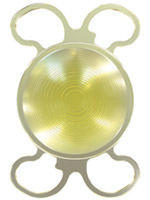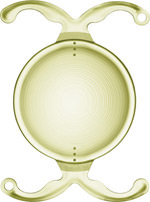Trifocals
Natural vision at all distances.
Objective: Refraction 0 with trifocal lenses.
What does the patient who gets the crystalline operated expects?
- First of all, having the view as the patient had when he/she was young
- Being able to see without glasses at all distances and seeing properly in any light level
- Getting rid of his or her previous graduation either short- sightedness or long-sightedness with or without astigmatism.
- Reading a book, the newspaper, projects, the food composition etc, without any problem.
- Using mobile phones, tablets and computers without any visual limitation.
- Day and night driving, going to the cinema and reading subtitles without any problem.
- Reading the teletext on the TV.
Nowadays when people start worrying about getting old, we can´t help trying to keep our youth vital function.
What technology can offer us?
 All the success is mainly due to the technological development of the lenses we put inside the eye after removing the cataract. Its optic design has progressively achieved the fact that images can remain focused regardless the distance.
All the success is mainly due to the technological development of the lenses we put inside the eye after removing the cataract. Its optic design has progressively achieved the fact that images can remain focused regardless the distance.
In fact it is a focus artificial system whose results have obtained high optical quality levels in the last years.
The last progress has been the trifocal lenses, which on top of other kind of lenses have improved the intermediate vision, which is necessary to work with computers. Moreover, they had provided better visual quality at all distances. On its surface concentric delicate rings are defined.
When the patient has astigmatism we also have the same lenses with the astigmatism correction included in its design. Those are the multifocal toric lenses; thus we can offer the patients a good product and they all can meet their needs.
What results can be achieved with the trifocal lenses surgery?
We can get quality vision at all distances. Using the latest trifocal lenses the patient expresses a huge visual satisfaction the following day of the surgery in most of the cases.
However, we cannot forget the fact that the result is not perfect in 100% of patients (as it is not in any medical procedure either)
The slight dissatisfaction may be due to the vision of some reflexes with the shape of circles around light focuses at night. As well as that, some patients may need glasses with one dioptre to aid their close vision when there is low light.
The main frustration is given in some patients whose vision suffers some vision quality defect called “optic alterations”. These may manifest in double vision of some objects or else in having difficulty to see at middle or close distances. In such cases the solution to the problem is not very complex, although it requires some surgery from an expert. The surgery consists of replacing the multifocal lenses by monofocal lenses. Thus the patient gets a quality long- distance vision but he still has to wear glasses for short and middle distance. Luckily those cases are very unusual. ICO has only had 1 out of 200 cases in the last years. Once the trifocal models have been used that statistic has lowered even more.
At ICO we provide and explain in detail all that information to our patient before having the surgery done. We believe that the patient has to be well informed.
What is the trifocal lenses surgery like?
It is carried out in the same way as any other intraocular lense. The contents of the crystalline is removed by means of the facoemulsion technique and the lense is inserted folded inside the capsule we have preserved. Once it is inside, the lense unfolds and it is centred. One of the main conditions is that the lense is well centred so that the multifocal effects are always concentric at the visual axis. The trifocal lenses are designed in a way that they self-centre successfully.
How long do the trifocal lenses last?
Forever!!!
Unless other problems in any other parts of the visual apparatus such as the retina, optic nerve or the cornea appear, the multifocal lenses perform its focusing function at all distances without alterations. It is a technique with no expiry date!
That´s why apart from achieving multifocal vision, the patient obtains long-lasting lenses which is an added value.
The patient achieves a similar vision as the one he had in his youth forever.
What is the vision like after the surgery?
The multifocal vision could be excellent the very next day of the surgery, or it may take some days since the brain has to adapt itself to a new way of processing and overlapping the information coming from each eye. This is the so called visual neuroadaptation. In some isolated cases that adaptation takes some weeks to be completed. During the first days after the surgery any visual task can be performed, although in a progressive way.

